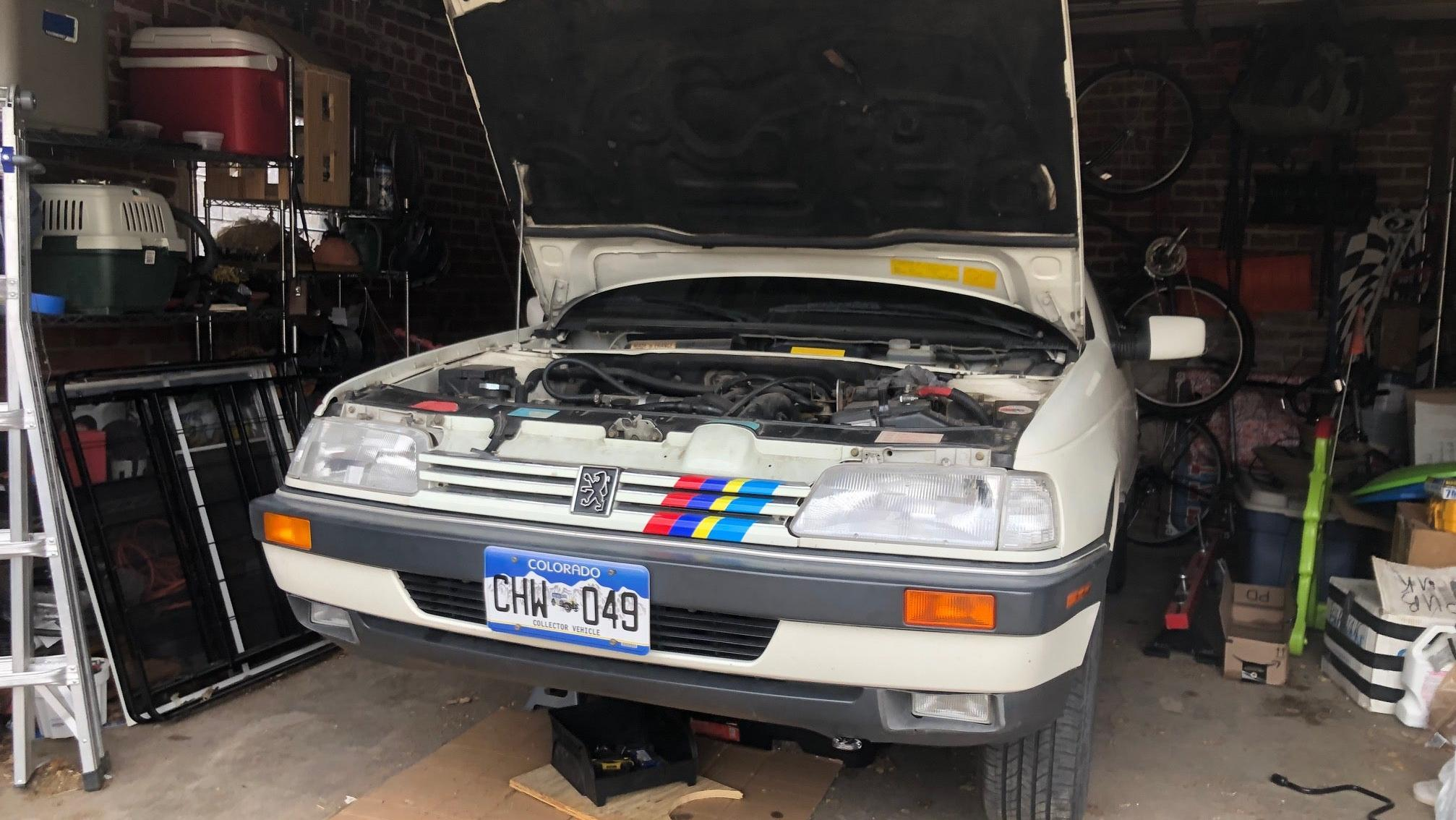Fixing My Leaky Peugeot Drove Me To The Brink Of Madness
The weeks-long saga of the simple repair that turned more complicated than I ever could have imagined.
Dave and I stood in my dimly lit garage. It was cold outside. It was only slightly less cold inside. The rain dripped through the ceiling onto boxes of Christmas decorations, gardening tools, and my 1989 Peugeot 405 Mi16, hood open, front end held aloft by jack stands.
We'd been at it for five hours. Most of it was spent on a single nut threaded tightly onto a stud on the inside of my bumper, in a place where no one could see and where hardly any tool could fit. After nearly three hours, we'd finally managed to get the nut off. But now it was time for Dave Severenuk—a talented and experienced amateur mechanic and car expert—to get going home.
"Dave, what am I gonna do?" I asked him, trying to keep myself calm.
"You're going to fix your car," he assured me.
The headlights and indicators were removed. The bumper was only semi attached. The grille was on the other side of the garage. The engine was supported with a floor jack and a 2x4. The engine mount was somewhere on some shelf on one side of the garage or the other. The timing belt cover was stuck up on a shelf, too. Hoses hung limply from the bottom of my car. My old radiator was leaning against a cabinet. A new radiator was laying on a cardboard box.
My car had begun hemorrhaging coolant a few weeks before all of this. In an effort to fix it, I'd made a staggering number of bad decisions and mistakes, and now I couldn't even see my way out of it.
So right there, amidst the broken car and its various parts and the drips from the leaky garage roof and the plumes of my breath in the cold air, I slipped gradually into the verges of what felt like a full-on anxiety attack.
I've ruined it.
Now I not only felt frustration and panic and helplessness, I felt self-disgust. Not only at my ineptitude, but at my naivete, or worse, delusions. Why the hell did I ever think I could fix a car, let alone a 33-year old French car that not a single professional mechanic in the Denver area would work on?
"I can't fix it. I am only making it worse," I said to Dave, gesturing at the mess.
"It's all nuts and bolts, David," he replied. "That's it. Nuts and bolts."
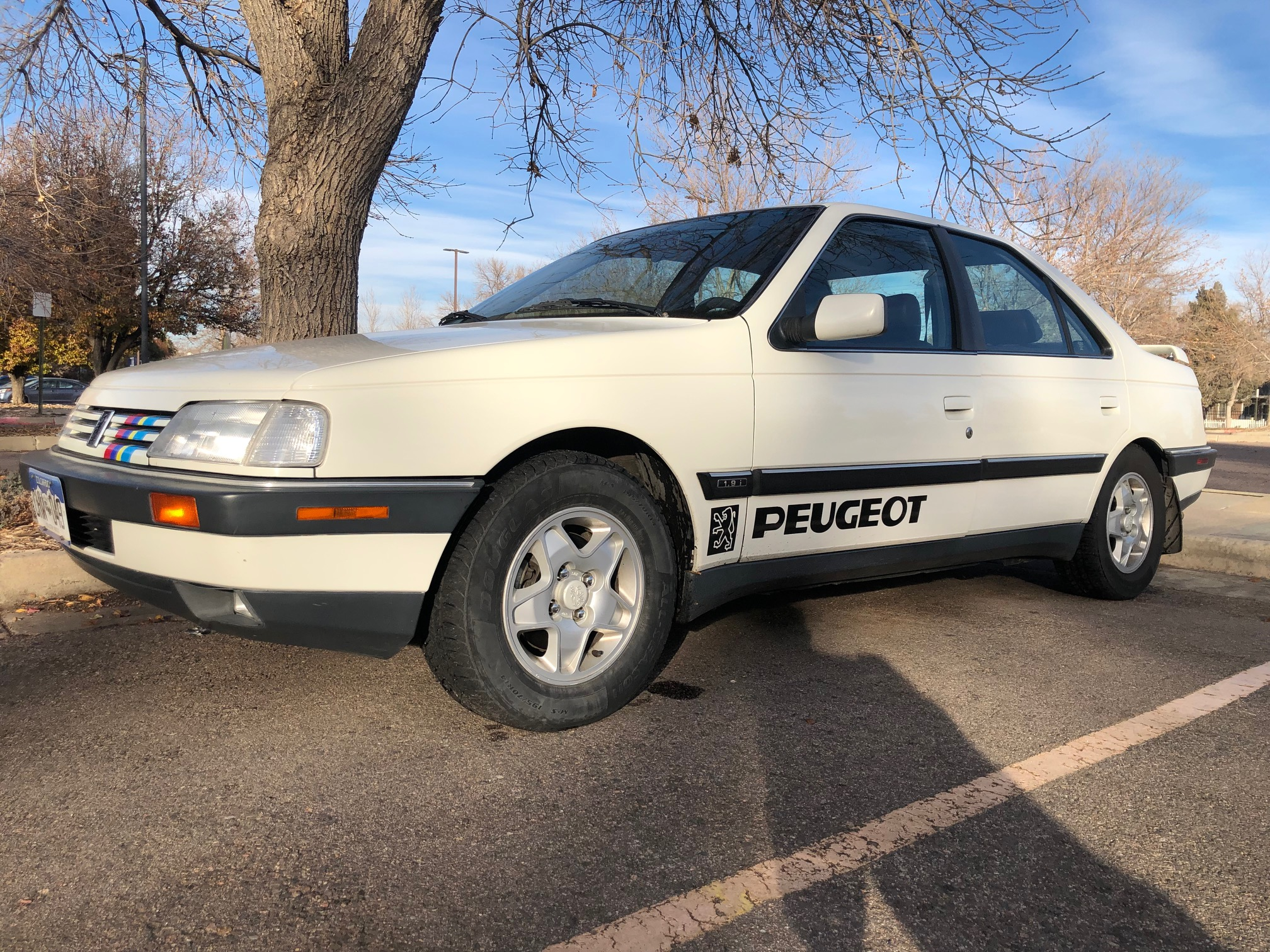
I got my Peugeot 405 Mi16 in the summer of 2021. It was my dream car. In a Road & Track essay co-authored by my friend Steve Edwards (who helped me purchase the car), I explained why this was a dream for me. I've always wanted a Peugeot, especially this kind, and I absolutely love it.
But also, know that this was supposed to be my more practical, reliable daily driver. Utterly ridiculous, since I live in a country that Peugeot abandoned more than 30 years ago. But consider my previous car: a Frankenstein's monster, the majority of which was a 1979 Alfa Sport Sedan crossed with a '71 Spider, an '87 Spider, and another Sport Sedan. It had over 200,000 miles on the clock. Maybe 300,000 — my mechanic couldn't be sure how many times the five-digit odometer had rolled over before I got it, but it rolled on my watch, too. It had diamond-plate sheet metal for door upholstery and non-functioning seatbelts in the rear. A host of other issues made it unusable for transporting our kids and unpleasant for anyone to drive aside from me.
By comparison, the '89 Peugeot 405 Mi16 was rust-free, accident-free, and had comparatively low mileage — only about 100,000 miles, which was 130,000 if not 230,000 miles less than the Alfa. And this was the performance version, sporting a 16-valve, 140-hp, 7200-RPM 1.9 liter engine. It was also the luxury trim. Electronic everything. Sunroof. Red leather seats, heated.
So while I knew it wasn't as sensible as, say, a Camry, you can hopefully see why I got myself into the situation I did.
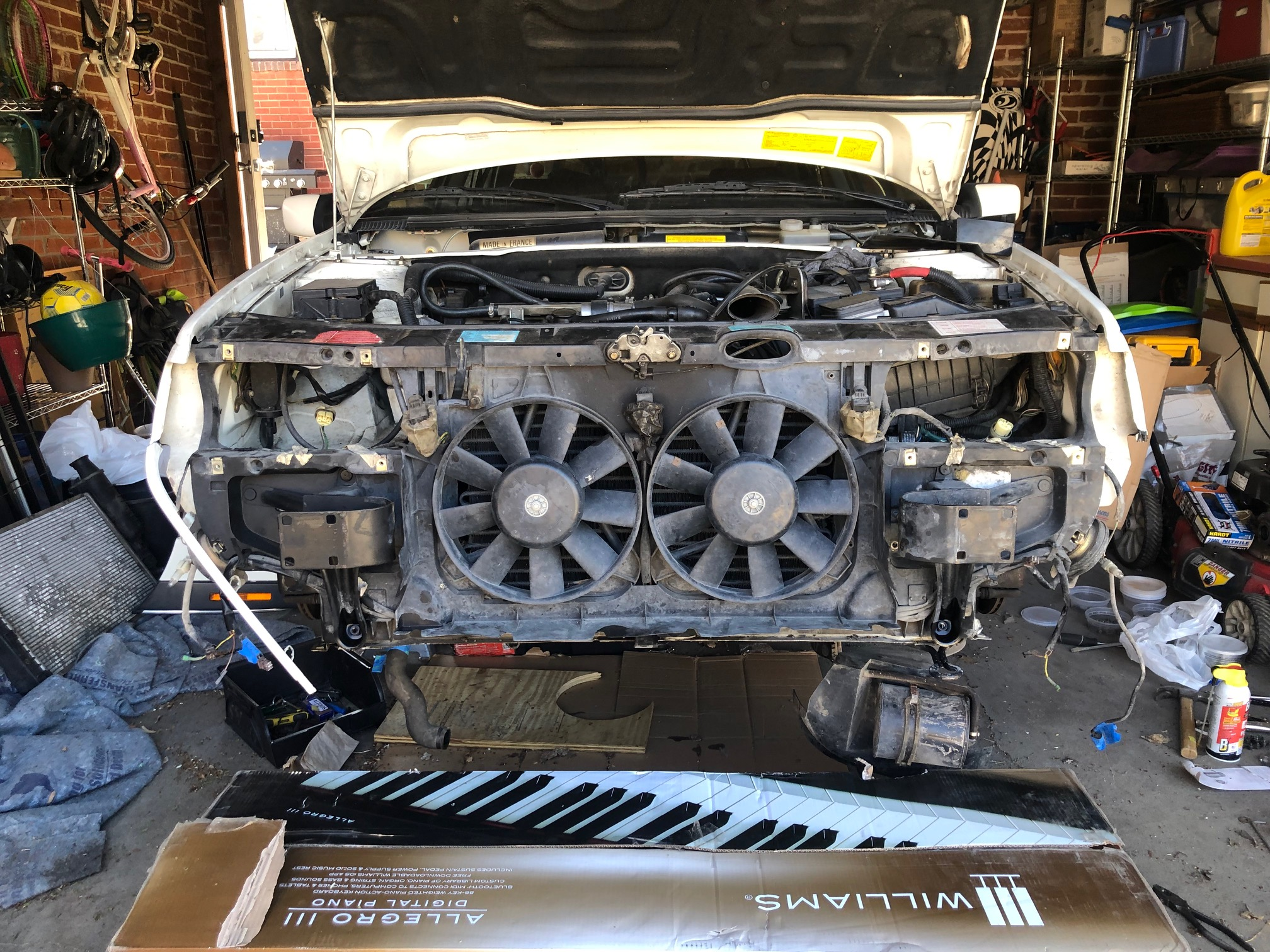
Seemed clear enough to me. A bad water pump. Had to be.
The car had been running dangerously hot beginning a few months before the coolant started gushing, and when it finally did gush, it wasn't from the radiator. It was coming from under the engine, on the passenger side. In other words, right where the water pump is.
The service records indicated the water pump had been changed about 35,000 miles earlier. Sure, that wasn't a ton of miles, but it also wasn't insignificant. Seemed plausible to me that it could fail.
There was one last thing that had me certain: experience.
I've had water pumps fail before. In particular, the water pump on my Alfa had just failed right before I sold it and bought the Peugeot. So here I was with my Peugeot displaying pretty much the same symptoms as my Alfa, which were: 1) the car was overheating, 2) coolant was pouring from right around the water pump.
I had successfully changed the water pump on my Alfa. Granted, while others could have gotten it done in, say, a day or less, it took me at least a week, and it was a frustrating, worrying process.
I had done it before, so it stood to reason that I could do it again. All I had to do was read up on the job, which I figured had to be pretty similar to the Alfa. Right?
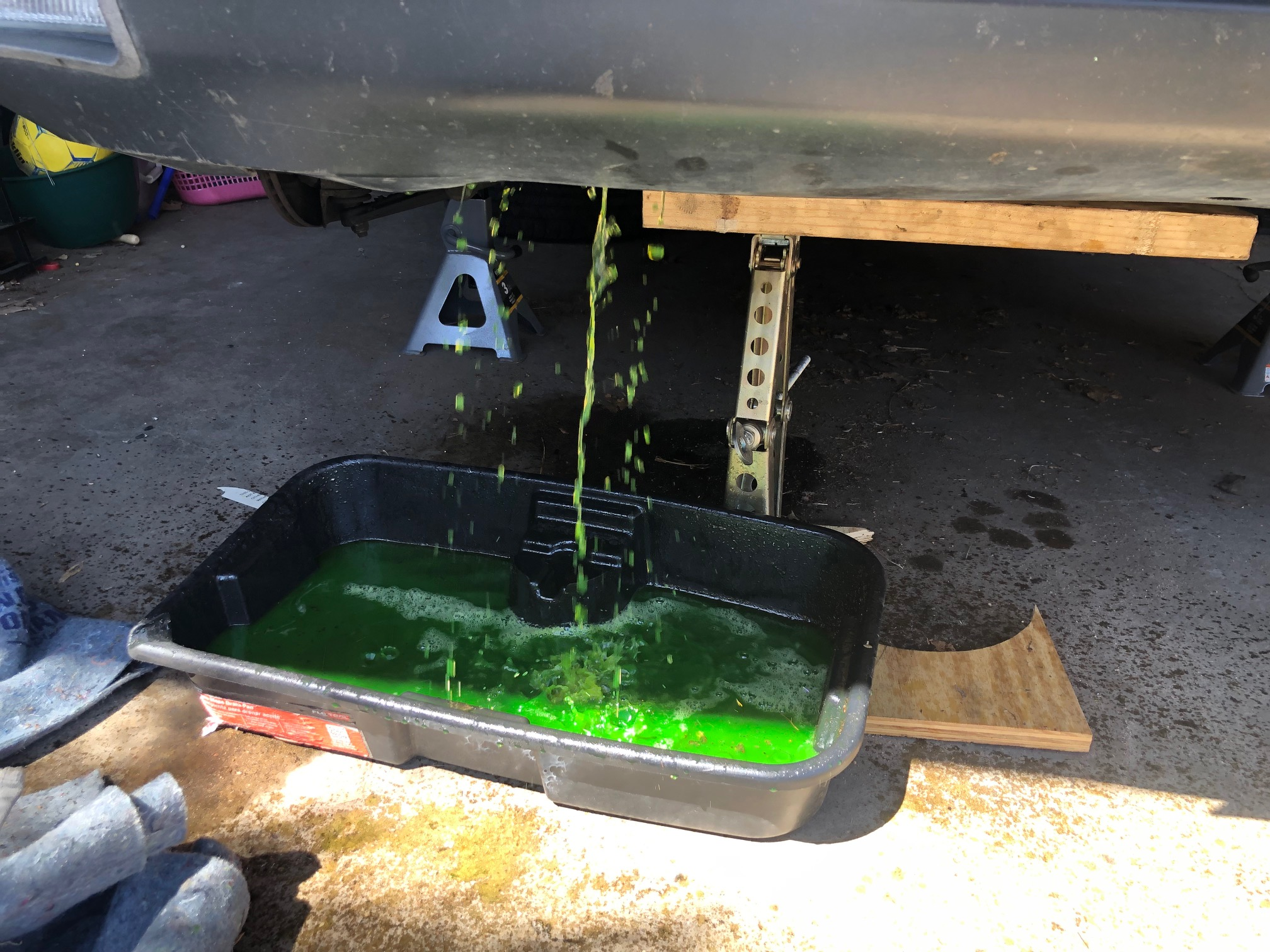
I checked out my Haynes Manual and saw pretty immediately that for all of my whining about the Alfa's water pump, I would now be begging for such an easy job. The water pump on the Alfa was mounted on the front of the engine, driven by a belt from the crankshaft. Aside from removing the radiator for access, all that was really involved was taking off a few belts and dealing with some stubborn nuts and bolts.
In comparison, the water pump on the Peugeot is between the motor and the passenger-side strut. It's mounted on the side of the engine inside of the timing belt cover because, in fact, the water pump is driven by the timing belt. So access issues aside, in order to remove and replace the water pump, the timing belt needs to be removed. And if you're removing a timing belt, well, you're replacing it.
In the process, if any of those pulleys are moved even slightly from their proper position, the timing slips, and that could be the end of your engine. For my purposes (here in the U.S., where an XUJ94 engine isn't easy to come by), the end of the engine means, of course, the end of the car.
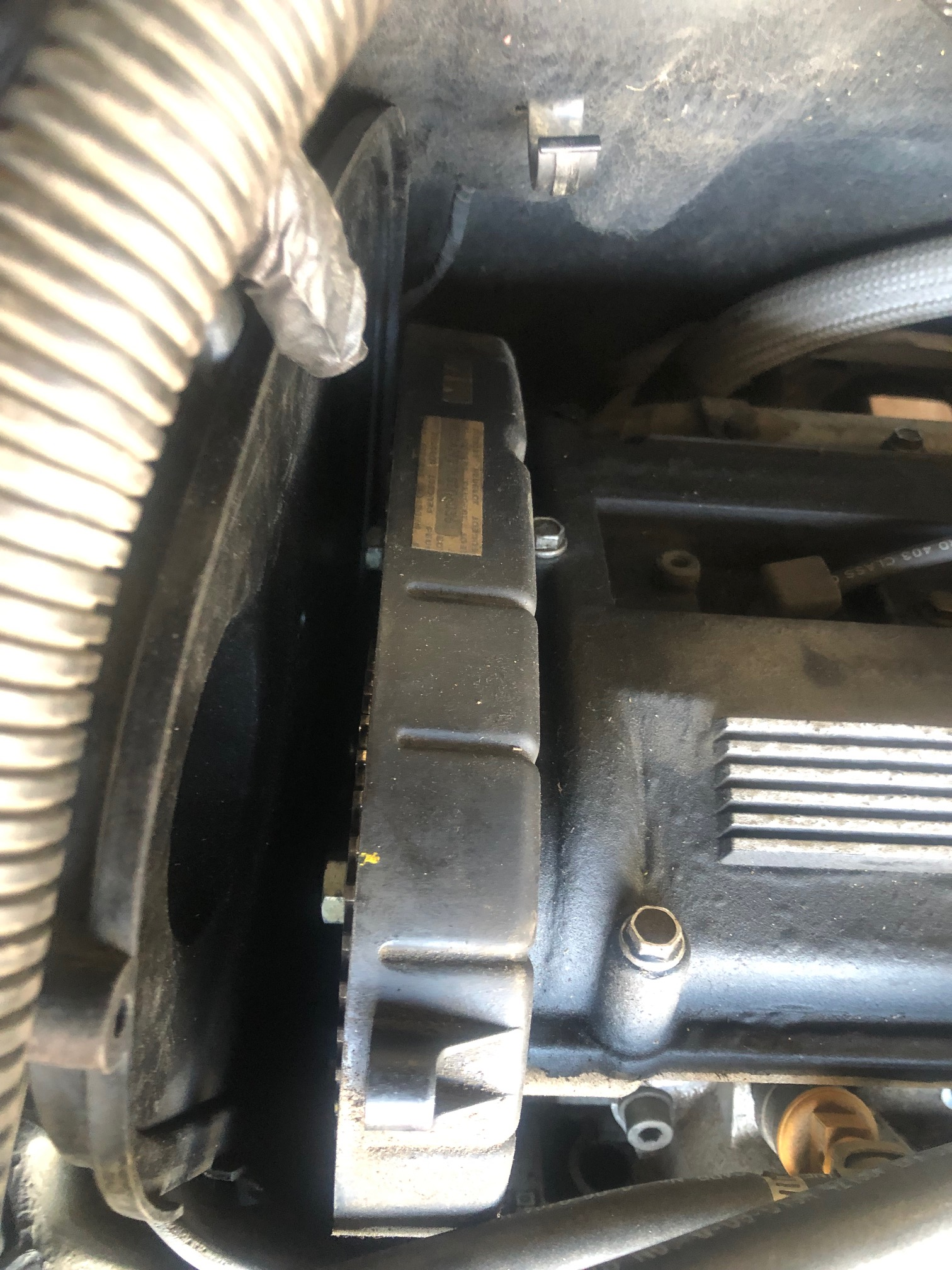
It would be difficult to overstate just how bad the access is. If you look up a timing belt replacement on my engine on YouTube, you'll get a very helpful instructional video that depicts the job being done on an engine completely out and away from the car in a large, spacious white room. To do it inside the car would mean working with only a few inches of space—just enough to fit a single hand. And then, I have no idea how you'd see what you were doing, since your hand would be blocking everything.
Imagine a desk with a solid back. Now imagine the desk is almost against the wall. There's an outlet behind the desk. Now imagine removing the old outlet and wiring up a new one, without moving the desk.
That's what it would be like. Except instead of it being an outlet, it's a timing belt and a water pump. And where messing up an outlet might trip the breaker, messing this up would make your house fall down.
I decided to be sensible. Rather than fix it myself, I called around to a few shops in my area. And then I called a few more. And then a few more. And then I called what may have been every single shop. None of them would touch my car. Some of the service managers told me their mechanics would quit if they had to work on a Peugeot from the 1980s.
My next step was to reach out to my friend Dave Severenuk, who had helped me replace a CV boot and some other parts when I'd first gotten the car. Dave—who's co-host of the excellent Apex Adjacent podcast—drew a healthy boundary: he could lend me tools, he could be on hand to answer questions or give some thoughts, maybe even swing by for an hour here or there, but he could not be my mechanic.
I think his exact words were, "I can't be your mechanic." Not a lot of wiggle room in that.
My last hope was my father-in-law. I'm very close with him. He's got a long history of wrenching on cars. Before he was even old enough to have a license, he took apart his parents' Beetle and put it back together just to see how it worked. As a teenager in the early 70s, he bought himself a '69 Camaro and worked on it. More recently, he rebuilt an old FJ40. He's currently rebuilding a '57 Chevy pickup with an LS swap. He knows his stuff.
So the next time we were all at his house, a few days after the coolant came gushing out of my car, I told him the situation and asked if he wouldn't mind doing a project with me. He's got tons of tools, he's got more space, he's got one thousand times the skills and knowledge, and hey, I could bring the family and we could make a weekend out of it.
He didn't say no. But he also wasn't sold on the idea that it was the water pump, even though it seemed completely obvious to me. I shared this with Dave as well as my friend Steve Edwards (another automotive writer, experienced wrencher, and the guy who actually found and facilitated my purchase of the car), expecting them to assure me that I was correct. But, instead, they wondered if maybe my father-in-law was right to have his doubts.
Odd, because it was so obviously the water pump. At least, it was to me.
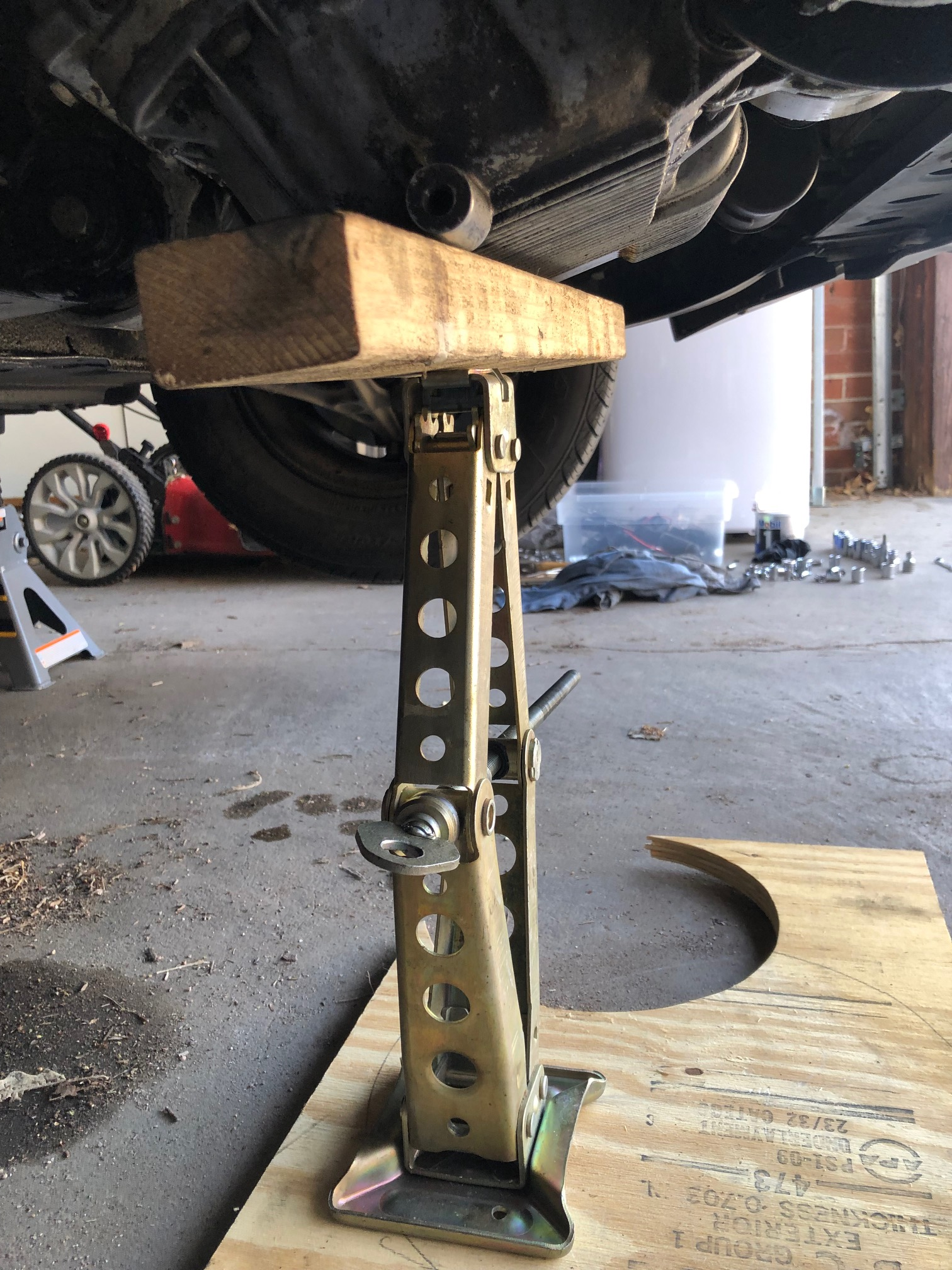
I mentioned earlier that my car had been running hot for a long time. Many months. I would sometimes share this observation on Twitter, and some of my UK/EU-based friends would theorize that the car was not really running hot, but just running the way Peugeots run. But as the months went on, the problem seemed to get worse, and while it never truly overheated, it got dangerously close to doing so more times than I could count.
I suspected faulty cooling fans. But then I tested them and their relays, and there were no problems there. I also suspected that the radiator was on its way out. So pretty early on, I'd had it in the back of my mind to change the radiator. I actually did buy a new radiator about a month before this crisis began.
Flash-forward a month or so. Coolant was gushing out of my car. Since I would have to drain the entire cooling system to replace the water pump, I figured this would be the perfect time to replace the radiator. I decided I might as well put a new thermostat in, too. So I grabbed one of those, excited that I'd essentially have a brand new cooling system.
Despite the fact that it was obviously a bad water pump, no one else seemed sold on the theory. My first job was to watch the coolant spewing from the pump to confirm my suspicions. I took the left front wheel off. I removed the wheel arch liner. I added more coolant and ran the engine. I was still unable to see the source of the leak, which only affirmed my suspicion that it was the water pump, which was hidden away behind the timing belt cover.
So, I removed the four bolts and the clip which secured the timing belt cover. Only thing to do now was to pull it up and out. I pulled it up, and it moved a few inches before it stopped. The cover was blocked by one of the engine mounts, which spanned from the top of the engine block over to the strut mount.
Removing the engine mount would mean supporting the engine with a jack. My first reaction was: no way, what the hell do I know about that? But my second reaction was, well, if you're going to redo the timing belt, you can sure as hell put a jack under the engine. And anyway, I'd read that jacking the engine up could give it a bit of an angle, which could create more space to work.
So, I took my roadside jack and a two-by-four and I put it under the oil pan and jacked it up until it felt sturdy. Then I removed all the visible nuts on both sides of the engine mount and pulled up with all my might — only to find that, of course, it wouldn't budge.
It took a full day for me to get the engine mount off. I could go on and on about why it took me so long, but it comes down to the fact that I really have no idea. With a French car, everything is new and different to me, and I just don't have the bank of experience that would provide good intuition.
And yet, I was able to immediately diagnose a bad water pump.
I did what I always do in these situations. I took to Twitter and posted my confusion and some photos. Twitter is quite helpful in these moments. Sure enough, detailed instructions came flooding in, and I was finally able to perform this entirely basic task.
And now, the payoff, I thought: I would be able to lift out the timing belt cover.
Only, I couldn't. It was still blocked — by what, I couldn't really tell anymore. It would almost come out, but not completely. Exhausted and frustrated and, most of all, feeling helpless, I took a hold of the cover and pulled and twisted and twisted and pulled until it suddenly came out with a terrible sound of scraping metal.
And there it was, somewhat visible in the dark shadow of the engine bay: the timing belt and its various pulleys. One of them, the water pump.
Hoping I hadn't messed anything up when I removed the cover by brute force, I put more coolant in the reservoir and started the engine.
To my great relief, the engine idled smoothly as it warmed up. An awful realization: this might be the last time I ever see it run like this.
Finally, the engine came up to temperature, and I heard coolant running into the drain pan I'd placed beneath the car. I peered into the engine bay with a flashlight. I couldn't see any leak. Confused, and knowing I only had so much time before it overheated, I crawled directly under the car, into the stream of coolant. That's when I found the source of the leak.
A hose. Granted, a hose that came off the back of the water pump, slightly vindicating my diagnosis. But that's all it was.
Every once in a while, it feels fantastic to be wrong. For all my insistence that this was another water pump failure, and for all my frustration that everyone doubted me, I was positively ecstatic to be incorrect. I texted my father-in-law and Dave and Steve and told them the good news.
I came into the house with a gigantic smile on my face. Hell, I was practically weeping tears of joy.
My wife took a look at me. "Wow you fixed it already?"
"No," I told her. "But turns out it's just a hose!"
And for one moment, it felt as if I might have a very short path to victory.
How very wrong I was about that. Not the good kind of wrong, either.
This was not a special hose. It was just a short length that came off the back of the water pump, only about ten inches long. No special molding. Just a short rubber tube.
All I needed to do at this point was take the old hose off and put on a new length of hose. In that moment, if you had asked me, "what's wrong with your car?" I would have answered, "I've got a hole in a hose."
And yet, what followed was a parade of errors. So many, it's all a bit of a blur. Rather than focus my meager talents on that single length of hose, I decided to take a more ambitious path. I must have been thinking that with the system drained, now was a great time to tackle the radiator.
First, I unscrewed the drain plug expecting a torrent of coolant to come out. A few drops was all I got. I put some needle-nose pliers up into it and pulled out a bit of gunk. A little more coolant came out.
"Aha," I thought. "Radiator's clogged up. All the more reason why I should replace it."
Removed the lower radiator hose, and coolant came gushing out. Then I removed the top hose. And then I removed the other hoses. Finally, there was one very small hose left. I gave it a good pull and sure enough, it slipped right off.
I looked around and spied one last thing: some wires. Not that I knew it at the time, but this was the water level sensor. It was positioned amongst the hose outlets toward the inside bottom of the radiator. Difficult to see. But with care, I was able to remove the plug from the sensor.
The radiator was now entirely detached from the car. All it was held in by was two spring-loaded clips at the top. So I pried those up and lifted the radiator.
It moved an inch or two and then it was stuck, wedged between the engine and a strip of thick plastic that ran along the front of the engine bay. I could only guess that this strip of plastic prevented rushing air from escaping over the radiator.
Seemed like this strip of plastic was held on by two bolts on each side. So I removed those. But when I went to lift this strip of plastic, it wouldn't budge. I consulted the Haynes manual but it didn't say anything about removing this strip. In fact, I couldn't find any mention of this strip.
So I took the grille off the car. That was easy enough. Just a few bolts. Now I was looking at most of the two fans surrounded by the heavy duty plastic shroud. This is when I noticed that this "strip" was the top of the very large, very heavy plastic shroud that went around the headlights and behind the bumper.
That innocuous looking black plastic strip on the front edge of my hood was the tip of the iceberg which was the Front Assembly. In order to remove that strip so that the radiator could come out, I would need to remove the entire front assembly, including the headlights and bumper.
This was not something I wanted to do. I did not want to disassemble the entire front of my car. I wanted to lift the radiator up and out, and then put the new radiator in. I texted Dave and Steve, and they sympathized, but assured me that taking that stuff off would make things a lot easier.
The Haynes manual has a dedicated section for removing the front assembly. There are a lot of steps. I followed them as best I could until I was quickly stopped out by a corroded and dirt-caked bolt. I was exhausted and frustrated.
I took stock of the situation, and it was not good. The timing belt cover was off. The driver's side engine mount was off. Both wheels were removed, along with the wheel arch liners. The grille was removed. The radiator was disconnected but still in the car. The coolant was drained. There was still a bad hose tucked up behind the water pump. I couldn't get the bumper off, which meant I couldn't remove the front assembly, which meant I couldn't remove the radiator, which meant I couldn't put the new radiator in.
In a moment of desperate frustration, I took my largest screwdrivers and jammed them between the body and the plastic strip. This gave the radiator a little more clearance. I grabbed hold of the radiator and pulled up. The delicate fins scraped and screeched, but it came free.
I immediately understood that I would be a fool to try to put the new radiator in with such blatant disregard. I would still need to remove the front assembly, but at least I had the old radiator out. And that felt good.
The good feeling was fleeting.
I rotated the water-level sensor to remove it, and heard the crisp crack of 30-year-old plastic snapping. The sensor came off in my hands, its locating tabs no longer intact. I had the vague idea this would be a problem down the line, but at the moment there were simply too many other things to concern me.
Then, before I called it a night, I decided to do something I should have done about six weeks earlier. I opened the box containing the new radiator to compare it with the old one.
Same size. That was good. What was not good was that the inlets and outlets were entirely different. My existing hoses were useless.
My Haynes manual had made occasional reference to this. For example, in the section about the cooling system, it says: "On later models, the radiator hoses are connected using a plastic bayonet-type connection." (It also says, "it is impossible to gain access to the lower radiator hose connections without removing the front body panel assembly...")
I hadn't concerned myself with those notes, though, because my car is a relatively early 1989 (the model was launched in '87 and has one of the longest production runs of any car in the world). What I hadn't considered was that, of course, the radiator I bought would be for a later model.
So, not only would I absolutely, definitely, positively need to remove the front assembly, I would also need to purchase an entirely new set of hoses.
I Googled the hoses. I couldn't find them. I called up autoparts shops. No luck. Then it occurred to me that perhaps there were some standard-to-bayonet adapters. To my surprise, some of the big-name auto parts stores seemed to carry them.
With that almost imperceptible glimmer of hope, I texted Steve and Dave and gave them the update. Dave volunteered to come over and help me remove the bumper in the next couple days. That, I believed, would give me time to source the hoses and adapters.
They say that when it rains, it pours. And right around then, it did rain for a few days. It also poured sewage all over my basement. The sewer line cracked and broke clear off the main sewer line out in the alley. It wasn't our property, but it was our line, and our responsibility, including digging up the alley and repaving it.
I was in deep shit. Literally and metaphorically. And, well, all I can say is that sometimes the universe is just a little too heavy-handed.
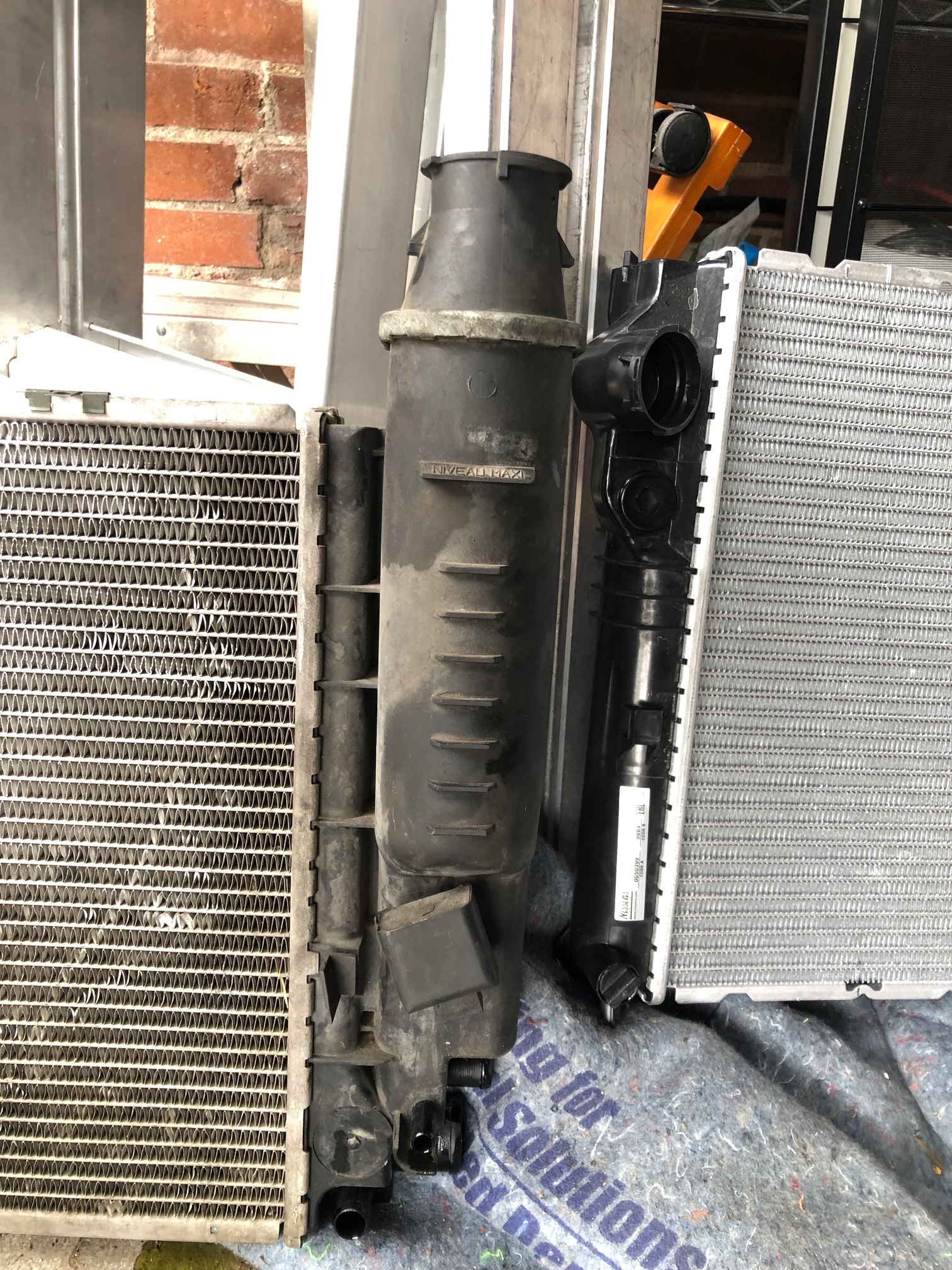
That day, I went to a number of auto parts stores. When I saw the adapters they carried, it was pretty clear they wouldn't work. I went ahead and bought them just in case. I had been wrong about everything so far. So, if I thought these adapters wouldn't work, then hell, it might just mean they would.
When we got started, the sun had nearly set and a light drizzle had moved in. Dave got to work on the stubborn, corroded bumper bolt that had stopped me out. I, meanwhile, tried to fit the adapters on to the radiator connections.
My suspicions were correct: they didn't fit. I had a brand new radiator that I couldn't connect to my car, and an old radiator that was all kinds of beat up and maybe even faulty.
I had no choice but to try to use the old radiator. It was more important than ever that we get this front assembly removed so I could more carefully reinstall the radiator.
Together, we removed the headlights and some plastic trim pieces. But the bumper proved to be difficult. Among the things securing it to the car were a series of studs that were set inside. These could only be accessed by reaching up into the bumper blindly with a socket wrench that barely fit.
We got about half of the nuts off those studs before Dave informed me he needed to get going home. At this point, it was nearly 11pm. The only thing we'd accomplished that evening was taking more things off my car that weren't broken in the first place, while getting dangerously close to breaking delicate plastic trim pieces that I likely wouldn't be able to replace. Otherwise, my bumper remained stubbornly affixed to my car. My new radiator was useless.
My car was moving further and further away from being fixed. I was having a difficult time even imagining it running again.
We put some stuff away in relative silence. And as we did, I felt my composure slipping away. I wanted to scream, cry, kick my car, kick myself.
"I can't do it," I said to Dave, helplessly.
"It's all nuts and bolts, David," he told me.
The day my car had started bleeding out its coolant, my sleep had become fitful, disturbed by anxious dreams where my car was in a thousand pieces, where my car was lost, where everything I touched on it came off broken in my hand.
I awoke the next day and did some writing. And then without much forethought, I put my coveralls on and went out to my garage. I got under the car, stuck my hand into the bumper and got to work. I stopped thinking about fixing my car. I stopped thinking about my car. Instead, I just thought of nuts and bolts. There were some stubborn, hard to reach nuts. Maybe I'd never fix my car, but I'd get those nuts off, one at a time. I could be as stubborn as they were.
And it was still my car. Mine to fix or to destroy. Mine to keep or sell. I dictated what would happen to it. One thing was for sure: it was not going to sit there, haunting our garage, and my dreams, all because I couldn't get some nuts and bolts removed.
The day went by in a blur. But by the end, the bumper was removed, set safely off to the side.
I came into the house. My family nervously asked how it was going.
"I'm getting close," I said, though I had no idea if that was true. All I knew was that I had a very rare feeling: I'd had a good day working on my car. Even if it wasn't any closer to being fixed, I put in a day under my car and enjoyed it.
That night, I fell fast asleep and I didn't dream.
But this isn't a movie, where uplifting music starts playing and the underdog becomes a hero. Life, as you know, is not that neat.
It was an important mental-emotional moment. But, from a practical perspective, even with the bumper off, I couldn't remove the front assembly. I kept taking stuff off, removing every single nut and bolt and following every step, but the front assembly simply would not budge.
My garage was becoming cluttered with takeout containers full of French nuts and bolts and washers. I started worrying about losing track of where things went and in what order. The front assembly wasn't removed, but it was loose, at least. I decided to see if I could squeeze the radiator back in without damaging it much more than I already had.
But first, I needed to deal with the coolant level sensor. Without the sensor in there, there would be a hole in the radiator.
So I took a roll of silicone tape, placed the sensor in its port, and wrapped the tape around the connection where it was supposed to thread on. Made it as tight as I could. Then I pried the front assembly up and away by an inch or two and eased the radiator back into the car. I won't say it was perfect, but compared to getting it out, getting it back in was much better.
At this point, I finally came to the realization that I should stop trying to fix more than I knew was broken. Rather than replace the thermostat, I decided to simply put the car back together. Accordingly, I reattached the hoses to the radiator. The final hose was a thin and soft thing that, for reasons I can't at all remember now, I decided to simply slide right onto its connection, which didn't even have as much as a lip around it. It just didn't seem like something that needed to be very tight, especially since I'd pulled it off without even loosening the hose clamp.
In that moment, I had a thought: Whenever I get my car back together, if a hose fails, it'll be this one.
Then I plugged the wires back into the coolant level sensor. And from there, I worked backwards as best I could remember, reassembling the front of my car. For the bumper and its hidden studs, I enlisted my 10-year-old son, because his hands were much smaller. He threaded the nuts back on, and I tightened them.
I spent that whole Saturday putting everything back the way I had found it. Somehow, I didn't even break anything else. By the end of the day, the car was reassembled, and it looked like a car again. I stepped back and admired my work. It was a great feeling seeing my car like that.
And then a moment of recognition: I was right back to where I had started. The actual source of the problem that had started this whole disaster in motion still hadn't been addressed.

The next day, I crawled back under the car. Now that I'd seen where the leak was, I could see the faulty hose just fine. The problem was reaching it. Between the chassis, drive shaft, and other parts, there simply wasn't much room work. It seemed like getting that hose off was going to be a real pain.
I got my trusty silicone tape, and as best as I could manage, I wrapped the hose. Unlike the sensor on the radiator, which I could do in the open and keep nice and dry, this was working in a tight, awkward, space. And to make matters worse, I was wrapping a hose that was coated with coolant and grease. To make matters worse, without the car running and coolant spraying out, I couldn't exactly see where the hole was. So I just had to hope that the wrap I was putting on the hose was squarely covering the hole.
I filled up the coolant and started the car, opening the bleed points to get the air out. It was a relief to hear the engine humming along like old times. But it won't surprise you to know that as soon as the car came up to temperature, coolant came spewing out of the damaged hose. The silicone tape unraveled and hung off the hose in coolant-drenched ribbons.
There weren't going to be any shortcuts. The hose had to come off and a new one had to go on. Plain and simple.
For the next couple days, I was back under the car. The screws on the hose clamps were impossible to reach, facing up. I resorted to my one and only skill: brute force. I took heavy duty pliers, grabbed hold of the hose clamps, and twisted and worked at them for about two hours. Finally, the clamps failed and broke off. From there, I slid the hose off its connections. Coolant rained down onto my coveralls, but I practically danced with joy as I held the busted hose in my hand.
I had done it. I had actually removed the broken part. And now I was going to replace it.
With my filthy coveralls covered in fresh coolant, I headed down to the local parts store with the hose. I'm guessing the guy who worked there might have mistaken me for a professional, because he immediately invited me back and let me go through all their hoses. I selected a few that seemed like a close match, bought those along with some new hose clamps, and headed back to my house.
After a few false starts, I fitted the new piece of hose onto the connections and tightened up the clamps. And then I laid there on the ground, marveling. I had done it. I had not just removed the broken part, but I had actually replaced it, too. There under my car—my 33-year old French car—there was a brand-new hose secured with brand-new hose clamps. And I was the one who had done it.
I topped off the coolant and fired up the car. The hose did not leak. I killed the engine and went into my house, declaring the job complete.
Of course, it wasn't really complete. I hadn't even driven the car, just idled it. So the next day, I decided to take a drive with my son to the store. We made it there just fine, though it seemed like the car was running a little hot. By the time we made it home, the car was very close to overheating. I pulled up in front of my house and looked underneath. Coolant was pouring out. This time from under the radiator.
I killed the engine and a few hours later, started it up long enough to drive the car up on ramps.
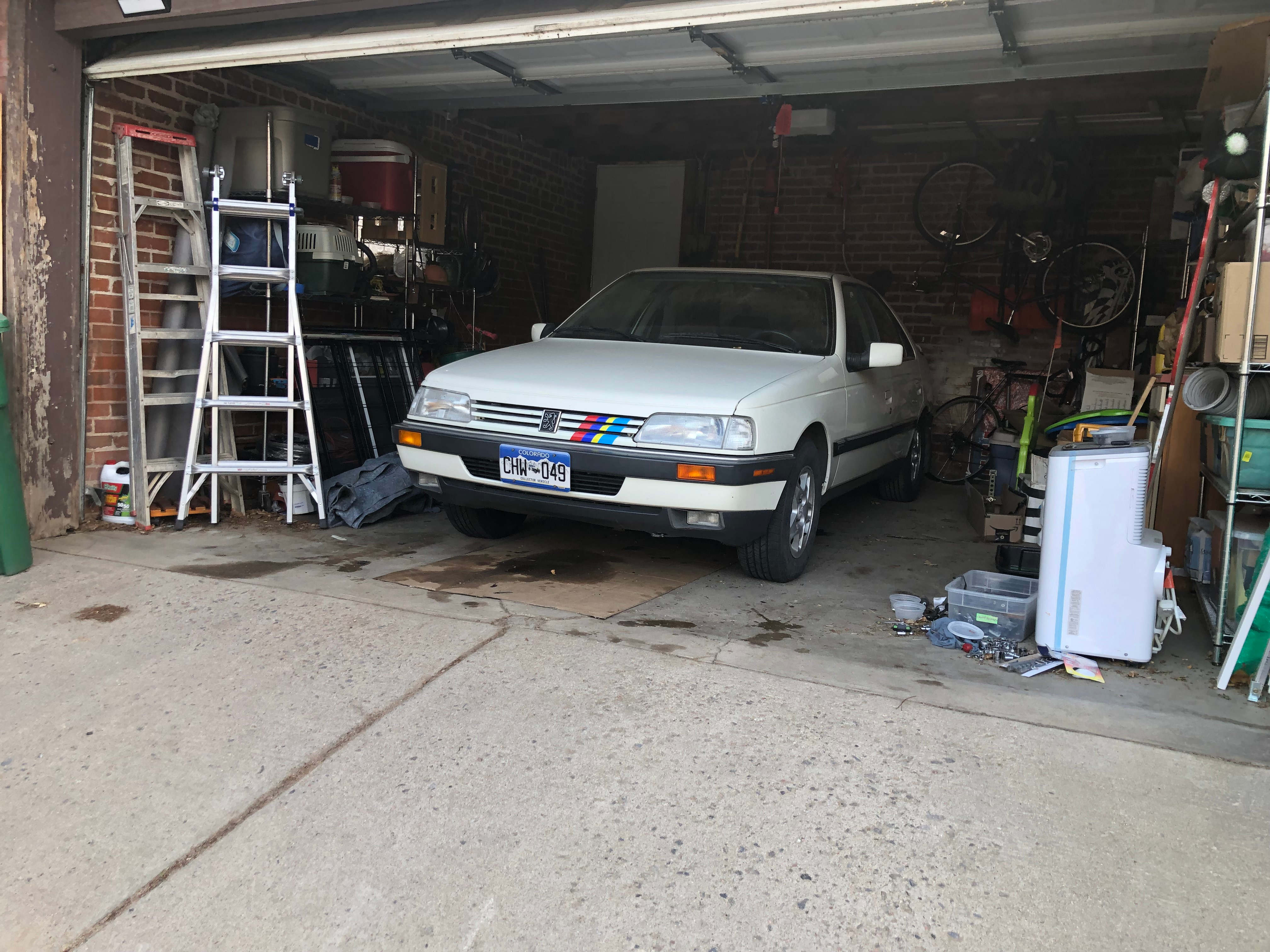
I have found that silicone tape can be a miracle when it comes to an air leak. But after I inspected the car, I had to accept that silicone tape doesn't work on wet, greasy things. And, beyond that, it probably wasn't meant to secure something that was highly pressurized with 220-degree liquid.
In other words, the tape that I used to reattach the temperature sensor had failed. There was no getting around it, I would need a new sensor.
My old, broken sensor had some numbers and letters on the back, so I looked it up and quickly learned that these types of things are not at all standardized. There was no way I'd be walking to the parts store and grabbing one.
So I contacted Javel, Inc., a place in Texas that sells NOS Peugeot and Citroen parts. With shipping, I was out another $60. Not a king's ransom, but certainly a high price to pay for breaking a brittle piece of plastic. But if you haven't realized this about me yet, I am an impatient person. With my car being inoperable for more than a month at this point, and with it being so close to fixed, I tried to think of what I could do in the meantime. That's when it occurred to me: a rubber stopper. After all, the spot where the sensor went was nothing more than a round hole. I headed down to the Ace Hardware and, for less than two dollars, I bought a few different sized rubber stoppers. With the best sized one, I pushed it into the sensor hole on the radiator. Then I used a mallet and tapped it in, nice and snug. Added more coolant and fired up the engine. No leaks.
For two glorious days, I drove around with a rubber stopper in the radiator. Even though the car ran a little too hot for my liking, it was holding its coolant.
On my third day driving it, a steady trickle of coolant began flowing from the radiator again. But it wasn't from the rubber plug. It was, of course, from that very small hose that I'd simply pushed back on to its outlet.
Now I was frustrated with myself. It would have been so easy to have properly attached the hose without all the other hoses in the way. I could have done it when the radiator was partially out of the car, when I had more room to work. But now I had to re-secure the hose without removing anything.
On the other hand, I was now so familiar with this part of my car, and so comfortable with being covered in coolant, I knew I could make it happen. I threaded a hose clamp around the hose. Then I got my wife to stand over it and hold the clamp in place with the biggest screwdriver I had. From under the car, I tightened the clamp until the hose was immovably secure.
A day or two later, the sensor came. With one last gush of coolant, I pulled the rubber stopper out and threaded the new sensor in place, somehow even plugging in the wires strictly by feel. I ran the car for the next week, and it behaved as it always had: it worked fine, it didn't leak, but it ran very hot.
Maybe all this time I'd been overthinking it. Maybe this is how the Peugeot was supposed to run.
And then I had a dream.
In my dream, I was filling my radiator with coolant.
As soon as I woke up that morning, I rushed out to my car and opened the radiator cap and looked inside. I saw nothing.
Even though I'd "burped" the system, there must have still been air in there. Plus, everytime I replaced a broken piece (the hose, the smaller hose, the sensor) and opened the radiator to refill it, it must have introduced more air into the system. Because even though it had looked like it was filled previously, I was looking into it now and it was bone dry.
I filled the radiator and re-bled the system. I took my time. And then I topped it off.
At this point, spring was giving way to summer. It was hot out.
I took my Peugeot out on some errands in the middle of a weekday. Found myself on Colorado Boulevard, one of the main north-south arteries of Denver. The traffic can be pretty bad. This particular day, it was awful.
It was hot that day. Very hot. Far ahead of me, I watched the light at the intersection of Colorado and Colfax go from red to green back to red again. The cars ahead of me barely crept up. I followed along, trying to will the cars forward. Red-green-red, and then we'd move about three car lengths.
Being stuck like this without moving is exactly what would cause my car to flirt with overheating. I spent months in traffic like this blasting the heater or even killing the engine during red lights. But now, I told myself not to touch the heater. I kept an eye on the temperature gauge. The needle marched up past 190 degrees, 195 degrees, 200 degrees. This would usually be when I'd start blasting the heat. I just watched, expecting it to gobble up the last 20 degrees or so of the gauge.
Instead, the needle stopped at 200, then it marched steadily back to below 190. In the year that I'd owned the car, I'd never seen it do that. The light turned green and then red again and I waited out two or three more cycles before I was finally able to make my turn. As I waited, I watched the car do the same thing multiple times over. The temp would climb to about 200 and then it would go back.
Amazed, I drove around for about an hour more. The car never got close to overheating.
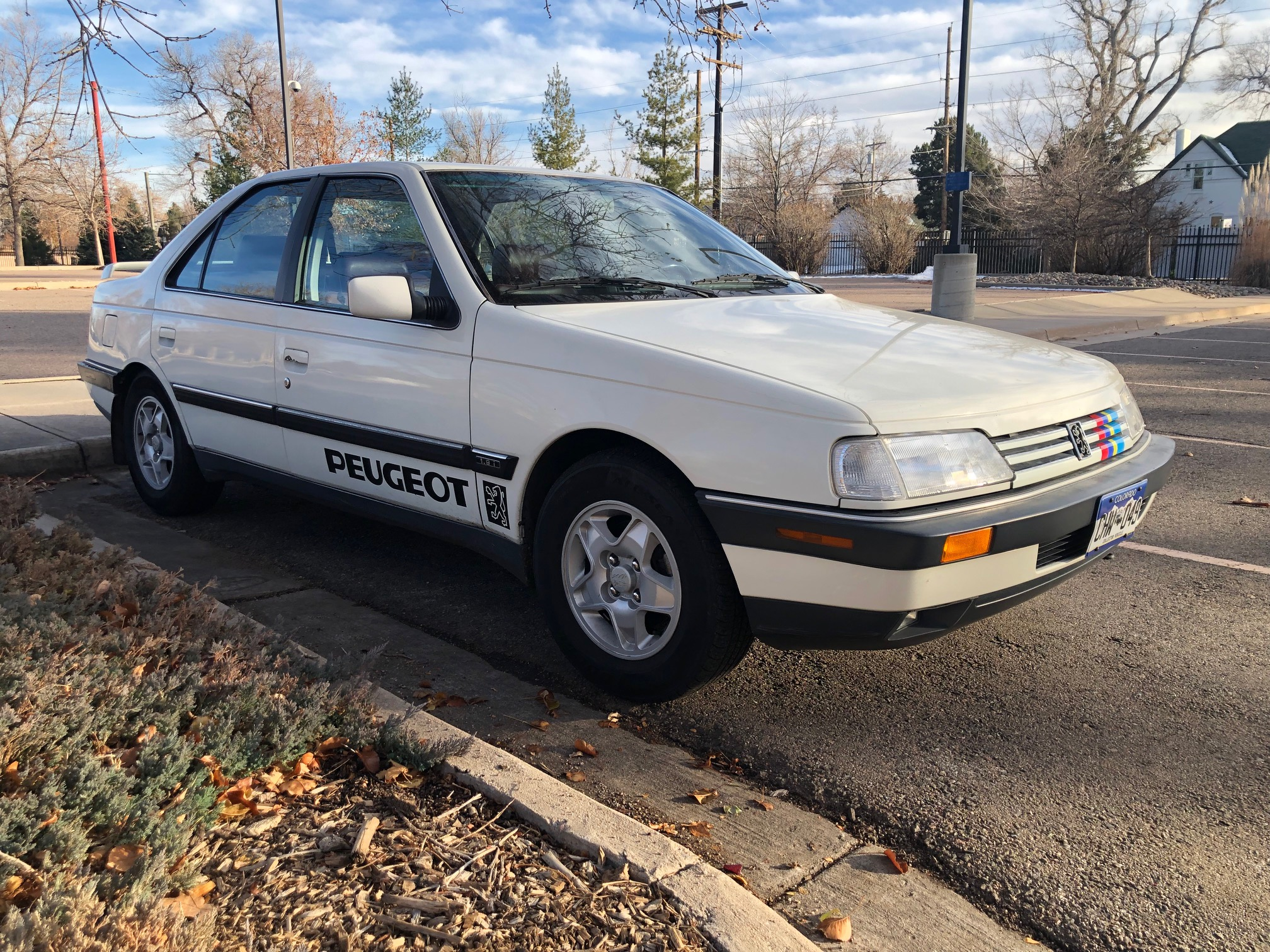
It's been more than a few months now. The car doesn't leak coolant. It doesn't overheat or even get close to it.
The vast majority of choices I made and things I did were wrong. I look back on the project, and I absolutely cannot believe that I took apart most of the front of my car, partially dismounted my engine, and nearly took the timing belt off, when all that needed to be replaced was a length of hose less than a foot long that I could get at literally any auto parts store.
I could have very well destroyed my car if I had followed my bad instincts any further than I did. I got right to the brink of maybe irreparably breaking my car. And, yet, at the end of it all, I fixed it. And aside from a little help (and tools) from a friend, I fixed it all on my own.
I had become Denver's only Peugeot mechanic. Maybe not a good one. Maybe one who has very little skill and even less self-confidence. But, hey, ultimately, it's all just nuts and bolts, right?
David Obuchowski is an essayist and author who writes about life with cars and other forms of culture. He is the creator/writer/host of the automotive/human-experience documentary podcast series, TEMPEST. His short fiction appears in a wide variety of literary magazines; his first children's book, How Birds Sleep — a collaboration with Sarah Pedry — will be published by mineditionUS (Astra Publishing) on March 28, 2023. His website is DavidObuchowski.com.
